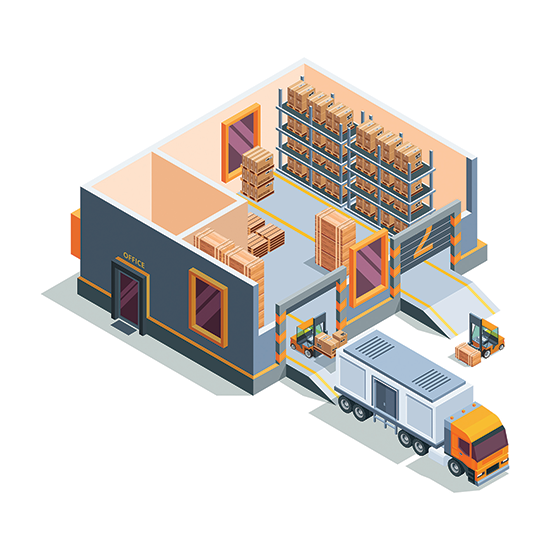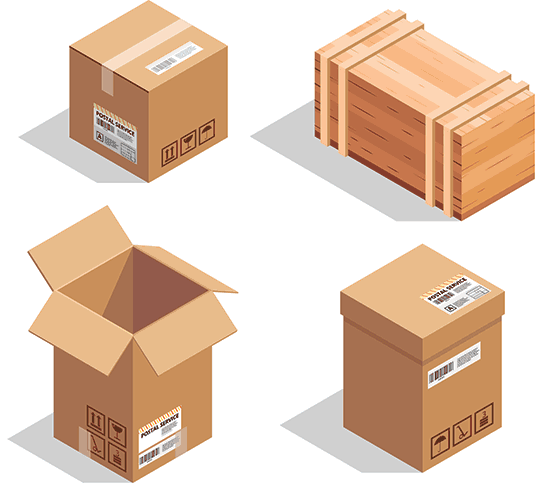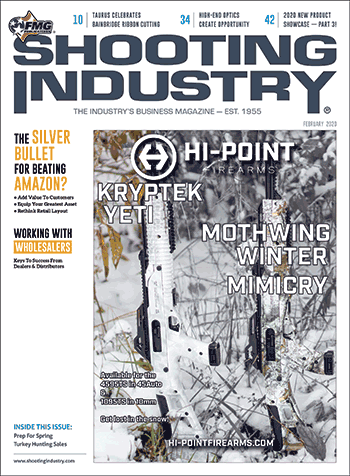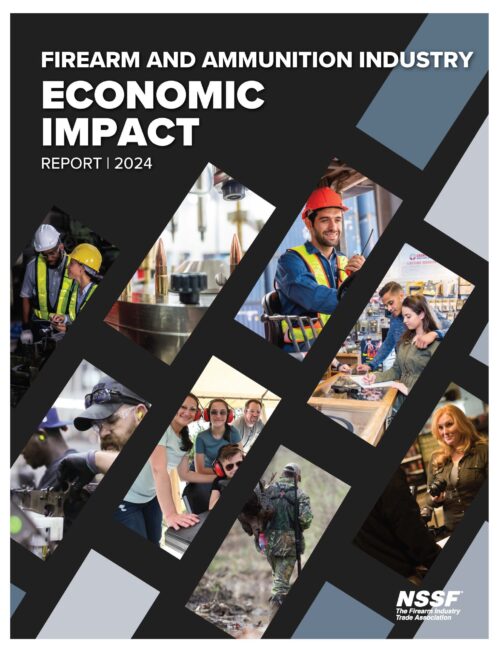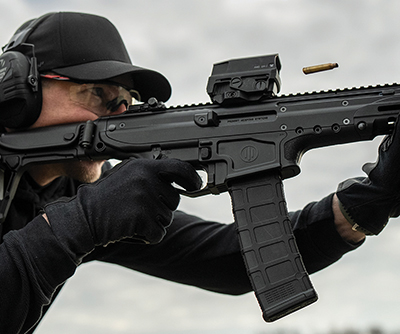Distributing The
Keys To Success
Entering the 2020s, it doesn’t take a lot of detective work to notice the significant amount of change the two-step distribution model experienced over the previous decade — especially in our industry. What hasn’t changed, however, is engaged, responsive wholesalers continue to be powerful partners for the storefront dealer.
Here, we’ll take a closer look at this symbiotic relationship from the perspectives of both groups.
The Dealer Perspective
John Phillips, founder and president of Poway Weapons & Gear (PWG) Range in Poway, Calif., shared an emerging trend has formed by forward-thinking distributors.
“Before AcuSport went out of business, they started something that has been continued through companies like RSR Group and Sports South: working for the dealer rather than working for themselves,” he stated. “They put the dealer at the center of the distribution wheel, instead of picking things off them as the wheel turned.”
Phillips explained this mentality reinforces the entire retail channel.
“If we want the marketplace to get stronger, we have to make the dealer stronger. It’s not about strengthening the wholesalers or manufacturers — that’s the end result of a stronger dealer network,” he said. “If the people who sell and promote the goods and have the consultative relationship with the end user are strong, then the distributors and manufacturers are going to be strong, too.”
Jeremy Ball, general manager of Sharp Shooting Indoor Range & Gun Shop in Spokane, Wash., has established partnerships with national entities like RSR Group, Sports South, Big Rock Sports and Crow Shooting Supply, as well as smaller regional distributors like Gunarama Wholesale.
“Two-step distribution is the standard purchasing model for the firearms industry and overall it works pretty well,” he observed. “Distributors tend to have more straightforward price structures than manufacturers and typically require lower purchasing amounts to meet shipping minimums.”
Tap Into A Larger Network
One asset of working closely with a distributor partner is access to real-time data, Phillips relayed.
“Understanding what a distributor’s top sellers are across the product line is very helpful. Since we’re based in California, what’s trending nationally doesn’t necessarily apply to our state — so where do I get the data to tell me what’s popular here? It’s helpful to have the reporting capabilities from distribution, which in the past distributors were unwilling or unable to extrapolate this data,” he said.
“The larger, more progressive distributors are driving this change,” Phillips continued. “The easier people make my business, the more loyal I am to them.”
Distributors help take out some of the guesswork on what product lines are stocked at PWG.
“Some distributors, like our rep at RSR, will look at our product catalogs and share why we should carry more of X or get rid of Y. We’ve seen a lot of great ideas come across using their knowledge instead of us trying to guess what the next ‘big thing’ is,” Phillips added.
Further, Phillips says distributors have recently helped take some of the risk out of running extensive promotions at his store.
“If we’re getting ready to have a sale on a particular item, we really don’t want to stock 100 units initially. What if we only sell five? So we’re starting to see distributors, and even some manufacturers, backfill and set some units aside for us after we place an initial order — which is very comforting,” he said.
Ball advises dealers to search out companies that take an active interest in enhancing your business.
“The rep for whatever distributor you’re working with needs to be invested in your business and striving to help you be more successful,” he said. “In turn, the distributor and rep will benefit when your business grows.”
Editor’s Note: Additional excerpts from this segment are available online — including tips for selecting wholesalers and insights for developing competent point-of-sale systems. Visit www.shootingindustry.com/distributing-keys-to-success.
The Distributor Perspective
“Retailers are the whole reason we are in this business.” — Jeff McGowan, Gunarama CEO Profound, but simple and real. These are the words from Jeff McGowan, owner and CEO of Gunarama (Spokane, Wash.), when referring to the business partners he has at the retail level. McGowan’s family has been in the distribution business for over three decades. In that time, they’ve watched the industry grow, but also change dramatically.
If being a distributor were easy, everyone would be doing it. Unfortunately, the business of distribution isn’t easy, and in the past year the industry has seen the loss of a number of significant firearm and accessory distributors. Most of these companies shutting their doors have been in the industry for decades so it has left some wondering about distribution’s future.
Across the board, manufacturers and distributors alike will tell you two-step distribution is actually growing more important. Political pressures, coupled with challenges in the insurance and banking arenas, along with a declining availability of credit options, means distributors — and the services they offer the industry — are more valuable than ever. Still, distributors realize the changing sales world and demands on profitability from manufacturers, all the way to retail, is demonstrating the need to continue making adjustments in their business operations.
Melissa Dubiel, vice president at Gun Accessory Supply in Oakdale, Calif., says the adaptability model is woven into the fabric of their 35-year history as a company, and won’t change.
“Gun Accessory Supply attempts to work with each customers’ unique needs depending on their business model and marketing strategy. No two customers are alike, some are very technical and want a ton of data, including inventory feeds, while others are still using fax machines and want a more intimate level of service,” Dubiel relayed. “Our strategy is to understand there’s no ‘cookie cutter’ retailer and we need to adapt to their needs, not the other way around.”
Communication Still An Art
When it comes to relationships with retail partners, McGowan says his number-one tip for retailers working with distributors seems so simple he was almost reluctant to point it out. With so many different communication channels available today, you wouldn’t think the art of communication would be a concern, but he believes it’s a critical factor in why some fail, or why some are so wildly successful, especially in the market’s toughest times.
“We communicate daily by email, our website, various social media platforms and of course over the phone. We find we prosper the most with dealers who really take the time to work with us and ask questions. Together, we can build a great partnership and get them the latest information. It can be a huge advantage and give everyone advance notice in understanding what’s hot and what’s not,” McGowan said.
Connected Partners
Truth is, distributors enjoy a very unique position in the shooting sports sales channel. Because they have direct connections with most manufacturers, and of course tens of thousands of retailers, it gives them a very clear picture about what’s happening in the marketplace. Those insights are exceptionally valuable for a retailer interested in tapping into it — it’s all there for the taking.
“This is the age of technology without a doubt,” Dubiel asserted. “Those retailers who have positioned themselves to take advantage of the surplus of information available to them digitally are reaping the largest rewards.”
She said retailers willing to plug their point-of-sale system into the inventory feeds and other data resources of distributors are actually able to use a distributor’s warehouse as an “extension” of their store and they can see inventory and order product in real time.
An Extension Of Your Team
Another way to view the relationship is actually leveraging a distributor (or in many cases multiple distributors) as if they’re an extension of your staff. Because most retailers work on a thin budget, with a small team, a true distributor partner can keep a retailer plugged into the various incentive programs and opportunities coming from manufacturers.
Distributors can help you make the right buying decisions, at the right time. They’re also often hearing about incredible retail success stories from across the country and are happy to share these tips wherever and whenever they can.
In addition, distributors see it as their mission to keep track of new programs, the latest and greatest trends (both nationally and regionally) and even safety recalls when necessary. If a retailer is so focused on day-to-day operations, and not asking their distributor partners to help them view the bigger picture, it’s easy to miss things. Distributors have a treasure trove of information they can share on a daily basis.
“I often counsel our staff it takes every person in this facility to get each box out the door, which means everyone is important to the process. It also means our executive management team isn’t afraid to jump in and help the warehouse pack a box, or to pick up the phone and take a customer’s order, or even help load the UPS truck at night if it is what’s needed to get the job done,” Dubiel said. “We treat our customers like our extended family and will do everything we can to service their needs.”
Simply, distributors exist to help retailers, and when a retail business understands a distributor can truly serve as a partner — a key component of their business operations — then the sky’s the limit in terms of what they can accomplish together.
“We want them to succeed,” McGowan said. “Because truly, it’s the only way we succeed.” When a retailer understands that, and uses those trust relationships to their advantage, it can really be a key in opening the door to success.

